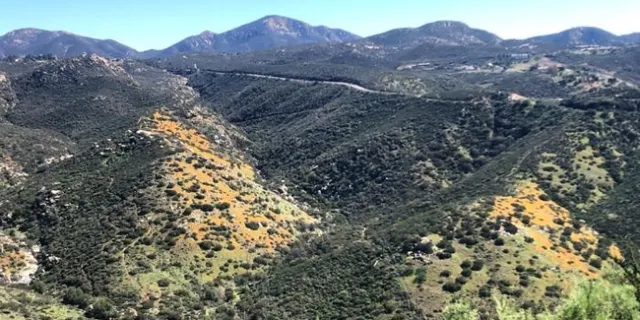
Aren't native plants supposed to survive on rainfall? Should I water them during the summer? If so, how much?
The answer depends on which plants are living in a particular site. Is the soil loamy, sandy, or heavy clay? What is the sun exposure? The high and low temperatures? How well-established are the plants?
Observing how native plants grow and thrive in the wild is instructive and can guide best practices for home gardeners to use. Note which plants thrive in sunny locations, or near water, or in rocky outcrops. In this photo, it's easy to tell the north-facing from the south-facing slopes.

Watering:
Because most California soil is dry during the summer, many native plants are well-adapted to those conditions and won't tolerate standing water. This is particularly an issue with clay soils that don't drain well. The excess water can cause roots to rot, or it can cause suffocation as the water prevents oxygen from getting to the roots. Watering an established native—meaning one that is 1-2 years old and has at least doubled in size—even just once a month during the height of summer can be enough to kill it.
This is also because California natives, and many other plants, rely on mycorrhizal fungi that live symbiotically in the roots of the host plant. These amazing fungi provide critical micronutrients and increase the absorptive capabilities of the plant's roots by up to one thousand times in exchange for the carbon provided by the host plant. Mycorrhizae even secrete chemicals that help to suppress weeds! However, the bacterial and fungal pathogens that can kill mycorrhizae thrive in warm, moist conditions, so too much watering in hot weather can be deadly for them.
In nature, plants with deep roots—such as oak trees—pull moisture from the water table and share it with other nearby plants. Roots will grow in the direction of a water source, and it is surprising how wide mature root systems are. Many have a root system three times the width of the crown. This illustration shows how the process works.

Knowing this, home gardeners can mimic nature by creating a bioswale, trough, or catch basin that collects water and allows it to be transferred to nearby plants. A garden designed with riparian plants inside a naturally moist or well-watered area with drought tolerant plants nearby takes advantage of this. Local riparian plants include trees such as Acer negundo (box elder), Cornus sericia (creek dogwood), Fraxinus latifolia (Oregon ash), and Salix gooddingii (San Joaquin willow). Riparian perennials and shrubs include Rosa californica (California wildrose), Vitis californica (California grape), and Erythranthe guttata (seep monkey flower). Calscape provides more examples and gives the general water requirements for California natives. WUCOLS IV (Water Use Classification of Landscape Species) is another very useful website for determining the specific water needs of thousands of plants.
Although they may go through a period of dormancy and survive without summer water, most native plants look better with judicious supplemental water. Another consideration is that extremely dry plants pose a fire danger. Some gardeners aim to shorten the period of summer dormancy by extending the watering period in the spring and fall. But it is important not to waste water by overwatering plants, particularly during drought conditions.
This may translate to watering young plants every week or two and established plants once a month. In general, established native plants should be watered deeply but infrequently enough to allow the soil to dry out in between watering. The top few inches should remain dry around small plants, deeper with mature plants. To water deeply, it is necessary to water slowly, allowing the water to soak in. If a heat wave is predicted, water before—rather than during—the worst of the heat. Watering early in the morning on a relatively cool day is best. Rinsing the dust off the leaves occasionally also helps plants look their best.
If drip irrigation is used, move the water source farther from the center of the plant as it grows. It is best to have several emitters per plant, placed at the plant's drip line. A single drip emitter near the crown encourages a small root ball and makes the plant more susceptible to rot and diseases.
Overhead sprinklers do not work well with most non-riparian native plants. A light watering that simulates a summer storm early in the morning will probably not harm the plants, but anything placed close to a sprinkler head will probably get too much water. Light hose watering is a preferable way to water, but not directly on the crown of the plant. It's better to spray the water around the drip line, a few feet away from the root ball.
Whatever method is used, it is important to check the soil before watering rather than to keep to a schedule. If the soil is moist at the root level—checked with a moisture meter or simply by poking a finger into the soil—it is not time to water, even if the surface appears dry. When in doubt, do not water! But continue to monitor the plant, especially if newly planted. Wilting leaves are not necessarily a sign that water is needed; confusingly, they can also indicate root rot caused by too much water.
Mulching:
Gardeners can take a cue from nature again regarding mulch. Many native plants create their own mulch with leaf litter. This type of mulch tends to be light and airy, allowing for good airflow. It doesn't wick moisture up from the soil, but still shades the roots, suppresses weeds, and helps maintain soil moisture and temperature. It also improves soil as it decomposes. So leaving leaves in place is a good practice, whenever possible.
Some natives, particularly desert and prairie plants, do well with gravel or rocks as mulch. Wood chips or bark work well with most other others, and shredded redwood bark is best for coastal and Sierra natives. Many do well with a large rock placed nearby.
Mulch should be 2-3” thick and kept away from the trunks or stems of plants. Ideally it is applied in the spring or fall, but more can be added in the summer if it is too thin, for all the benefits mentioned above.
Deadheading and Pruning:
Many native plants—including Monardella villosa (coyote mint), Verbena lilacina (lilac verbena), Mimulus spp. (monkeyflowers), Penstemon spp. (penstemon), Eschscholzia californica (poppies), and Salvia spp. (sages)—respond well to deadheading with new blooms, though some gardeners choose to leave the seeds for reseeding or for their value to wildlife.
Summer is a good time to tip pinch shrubs if you want to encourage denser growth. It is also a good time to thin or prune shrubs and trees, if necessary. Native evergreen trees are susceptible to disease if they are pruned in wet weather, so summer is a better time to prune them. Because requirements vary with different plants, it is best to check for reliable information on specific plants before pruning them and to use the services of a qualified arborist for pruning large trees.
Takeaways:
- Mimicking nature as much as possible with plant placement, watering, and mulching is a good way to be successful with California native plants.
- Checking the moisture level at the root ball is important. Allow the top few inches of soil to dry out between waterings.
- Watering deeply and infrequently is recommended for most non-riparian natives, but watering needs vary with environmental conditions and the age of the plant.
- Take advantage of resources such as Calscape and WUCOLS IV for detailed information on thousands of plants.
- Many native plants respond well to deadheading, tip pinching, and pruning during the summer; look at the requirements for specific plants.
For more information:
Bornstein, C., Fross, D., and O'Brien, B. (2005). California Native plants for the garden. Cachuma Press.
California Native Plant Society: Mulching basics. https://www.cnps.org/gardening/prepping-and-planting/mulching-basics
California Native Plant Society: Watering California native plants https://www.cnps.org/gardening/prepping-and-planting/watering
Calscape California Native Plant Gardening Guide. https://calscape.org/planting-guide.php
Las Pilitas Nursery: How to plant California native and other drought tolerant plants. https://www.laspilitas.com/planting.htm
Popper, H. (2012). California native gardening: a month-by-month guide. University of California Press.

